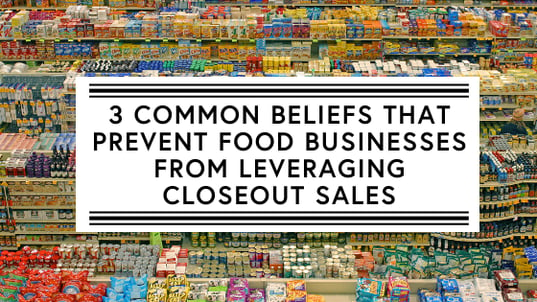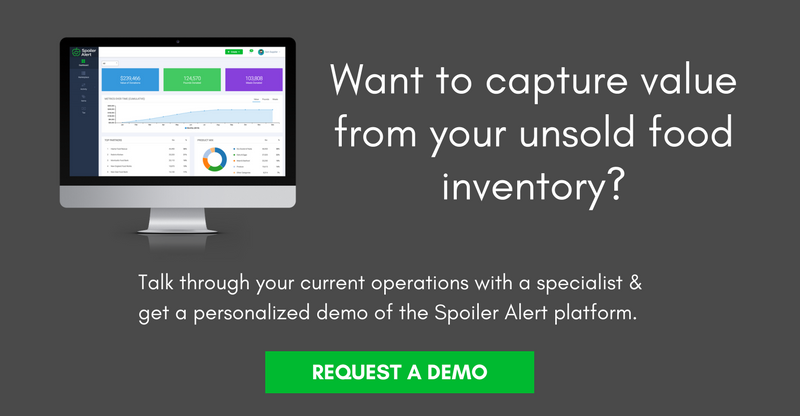
Businesses with best-in-class shrink management programs know that a holistic, coordinated food waste diversion strategy drives more value than a piecemeal, one-off approach. At Spoiler Alert, we are strong believers that building capacity to divert unsold inventory across a variety of destination categories in accordance with an item’s highest and best use is a key component to holistic food waste management. These destinations should include outlets for organics recycling, animal feed, donations to hunger relief organizations, and critically, closeout sales.
While each destination is important, closeout sales is a key category because it generates additional top-line revenue from surplus product and serves as a catalyst for investments in other donation and recycling initiatives. In spite of this, many businesses shy away from engaging with these outlets due to a number of commonly-held (but not always accurate) beliefs about the way that the closeout food market operates.
Throughout our experience helping companies better manage surplus, we have identified some commonly held notions that prevent manufacturers and wholesalers from leveraging closeout sales as a part of a holistic approach to waste diversion. While these impressions are often well-founded, we feel strongly that many of the risks that food businesses associate with closeout sales can be effectively managed by establishing standard operating procedures (SOPs) around buyer vetting and the development of a stronger network of closeout buyers that more adequately reflects the product’s circumstances and brand’s objectives. We address three of these beliefs below.
#1: Closeout sales will compromise brand reputation
Many companies harbor concerns that selling to closeout buyers will damage their brand reputation. More specifically, businesses often worry that existing customers will start to associate a lower price point or quality level with their branded products if they are frequently spotted for sale at a deep discount, nearing code date, and/or with damaged packaging.
While damage to brand reputation is an important consideration when leveraging closeout sales, this risk can be substantially mitigated by identifying and transacting with the right quality and quantity of closeout outlets. Regarding quantity, maintaining a broad network of outlets to sell to rather than relying on the same one or two outlets every time ensures that your product isn’t displayed at a discount at the same locations on a regular basis. This communicates to consumers that the bargain price is opportunistic rather than consistent.
As for quality, while questionable closeout buyers exist, they are largely outnumbered by reputable buyers that are eager to work with manufacturers and distributors as long-term partners. To identify such outlets while avoiding bad actors, businesses must dedicate resources towards vetting potential closeout buyers. Some of our favorite outlets, such as TJ Maxx, even have strong brand reputations of their own that are closely associated with both quality and value.
Another category of buyers to keep in mind for companies concerned about risk to brand reputation are institutions (such as nursing homes or schools) or niche retailers that cater to secluded and/or specific communities. Such outlets include the discount grocery stores found in many Amish communities, which cater to a hyper-specific demographic that does not overlap with most manufacturers’ regular customer base.
#2: Closeout sales will cannibalize my current customer base
Another common belief is that selling surplus product will cannibalize the current customer base. The concern? That existing retail customers will go out and find a manufacturer’s surplus products at a discount from a closeout reseller rather than buying them through traditional channels at fair market value. This would be a disappointing outcome, and we understand why this is a significant fear for food businesses as they consider leveraging closeout sales. As with brand preservation, however, this potential problem can be addressed by understanding, vetting, and maintaining close communication with closeout buyers. Specifically, working with end users (or buyers), as well as reaching consensus with buyers on any restrictions to product resale in advance, are effective strategies for mitigating this risk.
#3: Closeout buyers aren't interested in my product
We often find that businesses with surplus product inaccurately believe that what they have to offer is unattractive to buyers in the closeout market. For instance, if a product has damaged packaging, is past code date, discontinued or off-spec, they will assume that the product is no longer valuable to any buyer and automatically move forward with diversion to disposal outlets.
In reality, there are closeout buyers for almost every kind of product that is safe for consumption. This is increasingly relevant as USDA is investing in consumer awareness campaigns around date labeling guidelines and distinctions between quality and safety. The challenge is identifying appropriate buyers for a given product and communicating availability to a relevant audience. Unfortunately, most food businesses don’t have processes or tools in place to enable this type of targeted communication in a fast and efficient manner. Luckily, technology is enabling some companies to address this challenge more effectively.
Don't believe the hype
These three common beliefs have prevented many food businesses from recovering top-line revenue from closeout sales. Investing in the development of a thoughtful and robust closeout sales program allows businesses to overcome obstacles like reputational damage, customer cannibalization, and buyer identification, enabling maximum value recovery from surplus product.
.png?width=250&name=SpoilerAlert_WhiteLogo_LeftStacked%20(7).png)
